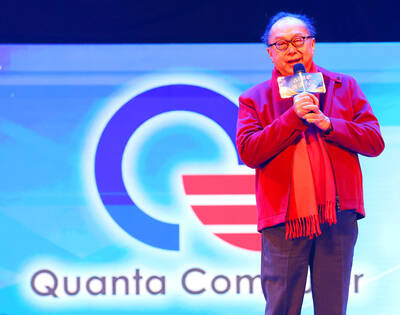Oil had its best week this year as signs point to a market that is achieving a balance between supply and demand.
Futures surged 8.6 percent in New York for the biggest weekly gain since December last year.
US crude stockpiles fell to the lowest since January, while gasoline inventories shrank to the smallest this year.

Photo: Bloomberg
The nation’s fuel use last month surged to the highest for that month in a decade, according to the American Petroleum Institute (API).
Russian Minister of Energy Alexander Novak said he sees the oil market rebalancing more quickly in the second half of the year.
Oil prices in New York are inching closer to US$50 per barrel, while futures in London surpassed that level earlier this week. Concerns are abating that efforts by OPEC and its allies to curb output will be offset by rising production elsewhere.
Kuwait joined the United Arab Emirates in promising to pump less after Saudi Arabia called on OPEC producers to improve compliance with their pledged cuts.
US shale drillers added just two oil rigs this week, Baker Hughes Inc data showed on Friday.
“You’ve got tightness. You had some big storage draws here in the United States,” Bob Yawger, director of the futures division at Mizuho Securities USA Inc in New York, said by telephone. “There’s less crude oil. That’s all there is to it.”
West Texas Intermediate (WTI) crude for September delivery on Friday rose US$0.67 to settle at US$49.71 per barrel on the New York Mercantile Exchange. The contract is up 8.6 percent from last week’s US$45.77 per barrel. Total volume traded was about 21 percent above the 100-day average. The US benchmark closed above its 200-day moving average for the first time since May.
Brent for September settlement on Friday added US$1.03 to end the session at US$52.52 per barrel on the London-based ICE Futures Europe exchange, up 9.3 percent for the week. The global benchmark crude, which also rose above its 200-day moving average, traded at a premium of US$2.81 to WTI.
Brent futures for the nearest delivery traded at a premium of US$0.30 to those for the following month, the largest premium since April last year. This pattern, known as backwardation, typically signals tighter supplies, while the opposite contango structure signals a glut.
“When it gets close to going from contango to backwardation, that is all you need to know about the spreads. If they go from one to the other, you are going from an excess to a shortage,” Yawger said.
Total deliveries of petroleum products, a measure of demand, last month climbed to 20.3 million barrels per day, according to the API.
Demand for distillate fuel and jet fuel rose, while gasoline consumption fell. US gasoline inventories last week fell for a sixth week to the lowest level since Dec. 23, Energy Information Administration data showed.
“In a big way, we’re having a switch of market expectations from one that thinks these inventory problems are going to persist forever and ever to a situation where increasingly markets are starting to believe in this whole rebalancing, particularly in the United States,” Bart Melek, head of global commodity strategy at TD Securities in Toronto, said by telephone.
Oil market news:
‧ Further deterioration of Venezuelan production is most bullish for Canadian and Mexican heavy barrels, RBC Capital Markets LLC analysts said in a note.
‧ Libya’s crude production would average 1.03 million barrels per day next year, up from a previous forecast of 843,000 barrels per day, Fitch Group’s BMI Research said.
‧ Eni SpA joined its oil-industry peers in posting a better-than-expected performance due to cost reductions, rising output and higher cash flow.

Intel Corp chief executive officer Lip-Bu Tan (陳立武) is expected to meet with Taiwanese suppliers next month in conjunction with the opening of the Computex Taipei trade show, supply chain sources said on Monday. The visit, the first for Tan to Taiwan since assuming his new post last month, would be aimed at enhancing Intel’s ties with suppliers in Taiwan as he attempts to help turn around the struggling US chipmaker, the sources said. Tan is to hold a banquet to celebrate Intel’s 40-year presence in Taiwan before Computex opens on May 20 and invite dozens of Taiwanese suppliers to exchange views

Application-specific integrated circuit designer Faraday Technology Corp (智原) yesterday said that although revenue this quarter would decline 30 percent from last quarter, it retained its full-year forecast of revenue growth of 100 percent. The company attributed the quarterly drop to a slowdown in customers’ production of chips using Faraday’s advanced packaging technology. The company is still confident about its revenue growth this year, given its strong “design-win” — or the projects it won to help customers design their chips, Faraday president Steve Wang (王國雍) told an online earnings conference. “The design-win this year is better than we expected. We believe we will win

Power supply and electronic components maker Delta Electronics Inc (台達電) yesterday said it plans to ship its new 1 megawatt charging systems for electric trucks and buses in the first half of next year at the earliest. The new charging piles, which deliver up to 1 megawatt of charging power, are designed for heavy-duty electric vehicles, and support a maximum current of 1,500 amperes and output of 1,250 volts, Delta said in a news release. “If everything goes smoothly, we could begin shipping those new charging systems as early as in the first half of next year,” a company official said. The new

Quanta Computer Inc (廣達) chairman Barry Lam (林百里) is expected to share his views about the artificial intelligence (AI) industry’s prospects during his speech at the company’s 37th anniversary ceremony, as AI servers have become a new growth engine for the equipment manufacturing service provider. Lam’s speech is much anticipated, as Quanta has risen as one of the world’s major AI server suppliers. The company reported a 30 percent year-on-year growth in consolidated revenue to NT$1.41 trillion (US$43.35 billion) last year, thanks to fast-growing demand for servers, especially those with AI capabilities. The company told investors in November last year that